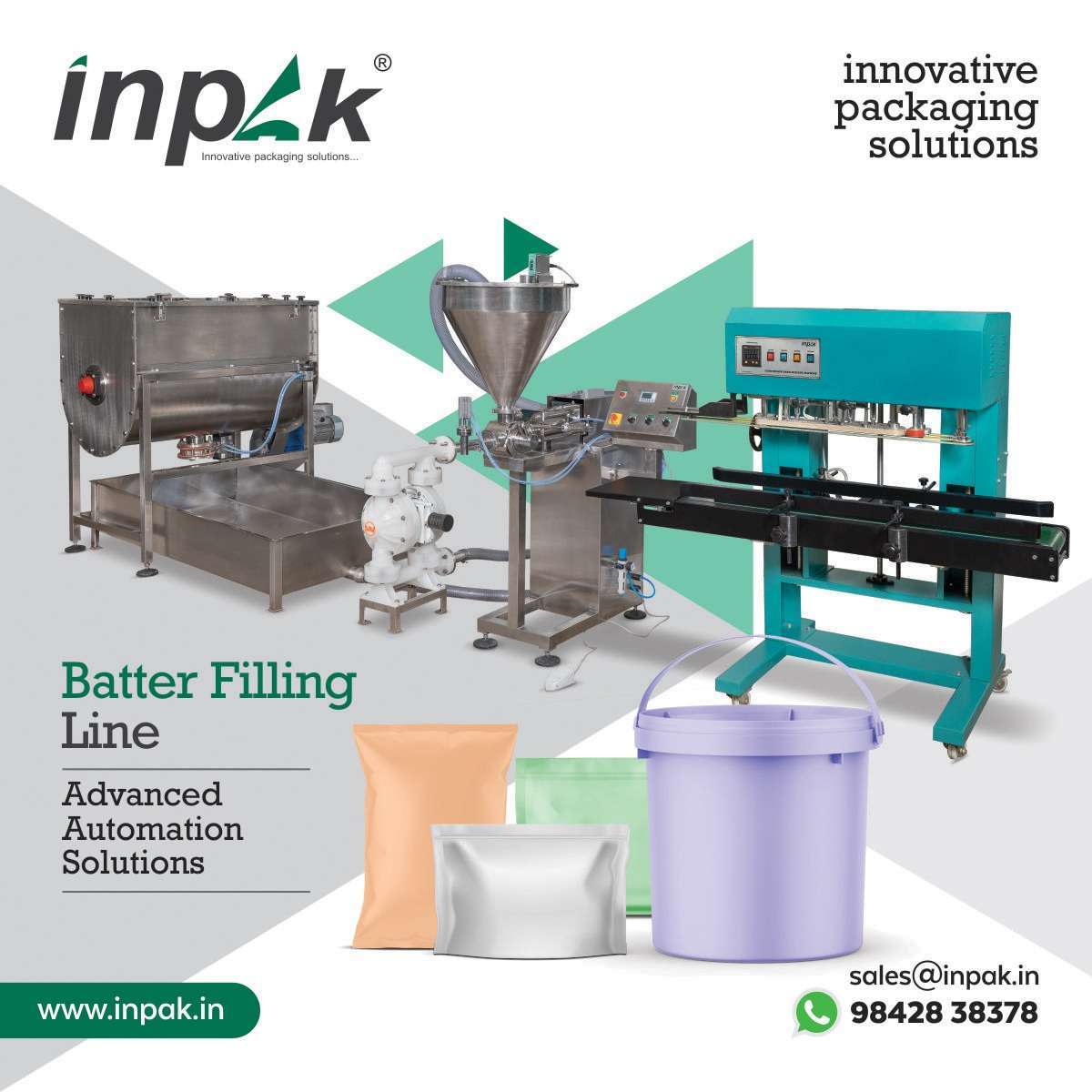- Home
- About Us
- Our Products
- Our Clients
- Blog
- Contact Us
Quick Enquiry
Batter Filling Line
The heavy-duty, Single/Double head piston liquid filler for all types of liquids, creams. pastes, gels, etc. containing particulate matter up to 7/8 in diameter. Volumes dispensed can range from 200 to 100ml per cycle, depending on the model selected. During a filing cycle, the product piston travels back to draw product from the hopper into a precision machined cylinder, then extends forward to fill. Product is dispensed into the bag or container through a filling nozzle and/pr cutoff device
 Ghee
Ghee Vegetable Oil
Vegetable Oil Rice Batter
Rice Batter Butter
Butter Pickle
Pickle Jams
Jams Shampoo
Shampoo Paste
Paste Yogurt
Yogurt
- Volumetric Liquid Filling system & Nozzle driving System
- It is widely used for batter filling and optional of milk, oil, ointment, shampoo, juice, liquor, perfume, wine, food product filling – in Bag, Jar, Can, vial, Bottle, Tub & any Containers.
- The unit can be quickly dismantled for maintenance just by opening the front cover
- Easy way to clean
- Each and every part can be attended for cleaning operation of maintenance without any hindrance
- S.S 304 elegantly matt finished body
- A unit to fill a variety of liquids and can be used for various type of bag or containers.
In the fast-paced world of food production, automation is key to maintaining consistency, hygiene, and productivity. Among the essential machines revolutionizing the food packaging industry is the Batter Filling Line—an advanced system designed to automate and optimize the filling of viscous food products like batters, creams, and semi-liquids.
This article offers a deep dive into the Batter Filling Line, exploring its cutting-edge features, business benefits, industry applications, and answers to frequently asked questions. Whether you’re a food manufacturer, a production manager, or an industrial automation enthusiast, this guide provides valuable insights into why this technology is a game-changer.
What is a Batter Filling Line?
A Batter Filling Line is a fully or semi-automated packaging system engineered to fill batter-based products into containers such as pouches, trays, cups, or bottles. It is specially designed to handle viscous and flowable food materials with precision, speed, and hygiene. From dosa batter and cake mixes to sauces and creams, this line ensures uniformity and consistency in every fill.
Key Features of the Batter Filling Line
High-Precision Servo-Based Filling Mechanism
Ensures accurate fill volumes for each cycle
Reduces product wastage and improves portion control
Hygienic SS-304/SS-316 Contact Parts
Made with food-grade stainless steel to meet hygiene and safety standards
Corrosion-resistant and easy to clean
Automatic Container Detection and No-Fill Protection
Prevents spills and reduces machine wear
Enhances overall line safety
Customizable Nozzle Designs
Adaptable to different product viscosities and container types
Supports drip-free and foam-free filling
Touchscreen HMI with PLC Control
User-friendly interface for easy operation
Recipe management for different products and batch sizes
Integrated Conveyor Systems
Seamless container movement throughout the filling process
Compatible with both inline and rotary conveyor configurations
Optional Add-ons
Automatic lid applicators
Date/Batch coding systems
Nitrogen flushing for extended shelf life
Benefits of Using a Batter Filling Line
1. Increased Productivity
With high-speed filling and low downtime, the batter filling line significantly enhances output compared to manual or semi-automatic methods.
2. Consistent Quality
Automation ensures that every container receives an exact quantity of batter, maintaining product uniformity across large batches.
3. Reduced Operational Costs
By minimizing manual labor and material wastage, companies experience a noticeable reduction in production costs over time.
4. Enhanced Hygiene and Food Safety
Enclosed systems and contactless operations reduce contamination risks, meeting stringent food safety regulations.
5. Flexibility Across Product Lines
The machine accommodates a range of viscosities and container formats, making it ideal for manufacturers producing multiple products.
6. Easy Maintenance and Cleaning
Quick-change parts and CIP (Clean-in-Place) systems allow for fast changeovers and less downtime between batches.
Applications of Batter Filling Line in the Food Industry
The Batter Filling Line is highly versatile and finds applications across multiple segments of the food industry:
Dosa/Idli Batter Packaging
Pancake and Waffle Batter Filling
Cake and Muffin Mixes
Sauces and Gravies
Yogurt and Custards
Ready-to-eat Food Trays
Foodservice & Retail Pouches
Whether you’re targeting domestic consumption or exporting to international markets, the batter filling line delivers the reliability and scalability required to meet diverse packaging demands.
Frequently Asked Questions (FAQs)
1. What types of batters can be filled using this machine?
The Batter Filling Line can handle a variety of food products with similar viscosity, including:
Dosa/idli batter
Pancake and waffle batter
Cake mixes
Custards and creams
Gravies and sauces
Its adjustable nozzle and pump mechanisms make it suitable for both thin and thick batters.
2. What container sizes and types are supported?
The machine supports a wide range of container types such as:
Plastic pouches (100 ml – 2 L)
Food-grade trays and cups
PET bottles
Glass jars
The filling line can be customized for your specific container dimensions and packaging formats.
3. Is the machine easy to clean and maintain?
Absolutely. The machine is equipped with stainless steel contact parts and is compatible with CIP (Clean-in-Place) systems. This ensures hygienic operation and quick cleaning between product changeovers. The modular design also allows for easy part replacement and servicing.
4. Can it be integrated with existing packaging lines?
Yes. The Batter Filling Line can be seamlessly integrated with upstream and downstream machinery including mixing tanks, sealing machines, capping units, and labeling systems. This ensures a smooth and continuous production flow.
5. How accurate is the filling process?
The servo-driven filling system ensures high-precision dosing with minimal variation, generally achieving an accuracy level of ±1%. This helps maintain product consistency and reduces overfilling or underfilling issues.
6. What is the production capacity of the Batter Filling Line?
Production capacity varies based on configuration, container size, and batter viscosity. On average, the machine can fill 20–60 containers per minute, with higher-end models reaching up to 100 CPM (containers per minute) for smaller fills.
7. Is the Batter Filling Line customizable?
Yes, the line can be fully customized to meet your production needs. Options include:
Single or multi-head filling stations
Viscosity control features
Nitrogen flushing units
Tamper-evident sealing
Date coding or thermal printing
8. How is product wastage minimized?
The system is designed with anti-drip nozzles, precise volumetric or servo-controlled pumps, and no-container-no-fill technology. These features collectively reduce spillage and material waste during operation.
9. What kind of power and space is required for setup?
Power requirements typically range between 3 to 5 kW, depending on the machine model and configuration. The space needed is generally 2m x 3m for a basic filling line, with room for conveyors and accessories.
10. Is operator training provided with the purchase?
Yes, leading packaging machinery companies usually provide on-site training, installation support, and a user manual to ensure smooth operation. Remote technical support and annual maintenance contracts are also commonly available.
Conclusion
The Batter Filling Line is not just a piece of machinery—it’s a strategic investment for food manufacturers seeking efficiency, scalability, and product consistency. Its cutting-edge technology, flexibility, and robust construction make it an indispensable tool in modern food packaging operations.
Whether you’re packaging dosa batter for retail shelves or preparing high-volume orders for food service, a batter filling line brings automation, hygiene, and profitability into perfect alignment.
If you’re considering upgrading your production line or planning a new facility, integrating a batter filling line should be at the top of your checklist.


